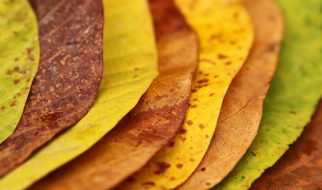
Actually, cultivars. Coffee cultivars are any variety produced by horticulture or agricultural techniques, therefore cultivated. In our periodic table of coffea varieties you?ll find all the major cultivars in history through modern types, including one whose origin hasn?t been named yet! Periodic table infographic made and originally posted by the Coffee Co-Mission.
Arabica ? Original variety. Represents between seventy and seventy-five percent of world production. Originally indigenous to the mountains of the southwestern highlands of Ethiopia. It is also known as the ?coffee shrub of Arabia?, ?mountain coffee? or ?Arabica coffee?. Coffea arabica is believed to be the first species of coffee to be cultivated. The earliest credible evidence of either coffee drinking or knowledge of the coffee tree appears in the middle of the 15th century, around Mocha in Yemen.
Robusta ? Original variety. The bean comes from the Coffea Robusta variety of the Coffea canephora plant (widely known itself by the synonym Coffea Robusta) which has its origins in central and western sub-Saharan Robusta is easy to care for, has a greater crop yield than arabica coffea, has almost double the amount of caffeine and more antioxidants than arabica coffea, and is less susceptible to disease. Roasted Robusta beans produce a strong, full-bodied coffee with a distinctive earthy flavour, but usually with more bitterness than Arabica due to its pyrazine content.
Gesha ? Original variety of Arabica. Alternate spelling of Geisha was created via marketing. Named originally from the village of Gesha, Ethiopia. It was planted in the 1950s as a rust resistant crop and rediscovered in the early 2000s. Now grown in the highlands of Boquete in Chiriqu Province, Panama, they are highly sought after at auction, achieving high prices. Geshas can also be found in Honduras and Colombia among other origins. These trees grow very tall and have beautiful, elongated leaves. The cherry and beans of this variety are also elongated in comparison to other varieties. Top quality appears to only result from coffee produced at extremely high elevation.
Typica, Bourbon ? Subvarieties of Arabica. Typica originated from Yemeni, taken first to Malabar, India, and later to Indonesia by the Dutch. It later made its way to the West Indies to the French colony at Martinique. Around 1708 the French planted coffee on the island of Bourbon (now called Runion) in the middle of the Indian Ocean from the plant the Dutch gave them. Unsurprisingly, it mutated slightly from typica and was planted throughout Brazil in the late 1800’s and eventually spread through Latin America. Bourbon produces 20?30% more fruit than Typica|Typica varieties. El Salvador is known as the Bourbon Country.
Canephora, Mauritania, Liberica ? Original varieties of Robusta. Native to tropical Africa, between Uganda and Guinea. The caffeine and antioxidant content is twice that of Coffea Arabica. Canephora has both upright and spreading forms. The Coffea Liberica tree grows up to 20 metres in height, producing larger fruits than those found on Coffea Arabica trees. This coffee was brought to Indonesia to replace the Arabica trees killed by the coffee rust disease at the end of the 19th century. It is still found in parts of Central and East Java today.
Charrieriana ? Original variety. Coffea Charrieriana, or Charrier Coffee, is the only coffee that is naturally caffeine-free coffee. It is a coffee plant from Cameroon that is newly discovered. Unlike the many popular types of Arabica and Robusta beans we find in commercially produced coffee, Charrier coffee is from a different variety of the coffee plant which is not yet commercially produced. It was only discovered in the year 2008 by Professor Andr Charrier, whose focus for 30 years was gathering and researching different varieties of coffee at the French research institute ?Institut de Recherche pour le Dveloppement? and it is accordingly named after him. At present, Charrier coffee is the only known caffeine-free coffee plant from Central Africa.
French Mission, N39, Mayaguez, Arusha, Jackson, K20, Kenya Selected, SL35 ? All sub varieties of Bourbon.
Pointu, Semperlorens, Caturra, SL34, Tekic, Pacas ? Mutations from Bourbon.
Acai, Mundo Novo ? Intraspecific hybrids from subvariety Typica and Bourbon mutation.
Sumatra, Bergendal, Rume Sudan, Amarello de Botancat, Blawan Paumah, Java Mocha ? Subvarieties of Typica.
Mokka, Arabigo, So Bernando, Pluma Hidalgo, Garodang, chickamalgu, Creole, Ethiopian Harrar, criollo, Kent, Maragogipe, Pache Comn, Villa Lobos, Blue Mountain, Villa Sarchi, Ethiopian Sidamo, Ethiopian Yiragacheffe, San Ramn, Sidikalang ? All mutations from Typica.
Hibrido de Timor, Icat, Devamachy, Arla, Bogor Prada ? Interspecific hybrids from Canephora.
Laurina ? Interspecific hybrid from Mauritania.
Kallmas, Kawisari, S26, S228 ? Interspecific hybrids from Liberica.
Pache Colls ? Intraspecific hybrid from Caturra (Bourbon mutation) and Pache Comn (Typica mutation).
Ouro Verde ? Intraspecific hybrid from Acai (Intraspecific hybrid) and Catuai (Intraspecific hybrid).
Catuai Garnica ? Intraspecific hybrid from Caturra (Bourbon mutation) and Mundo Novo (intraspecific hybrid).
Sarchimor ? Intraspecific hybrid from Hibrido de Timor (Interspecific hybrid) and Villasarchi (Typica mutation).
Pacamaru ? Intraspecific hybrid from Pacas (Bourbon mutation) and Maragogipe (Typica mutation).
Catimor ? Intraspecific hybrid from Caturra (Bourbon mutation) and Hibrido de Timor (interspecific hybrid).
Rasina ? Intraspecific hybrid from Typica subvariety.
Maracatu ? Intraspecific hybrid from Caturra (Bourbon mutation) and Maragogipe (Typica mutation).


